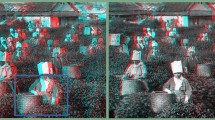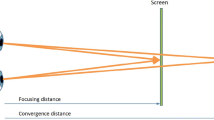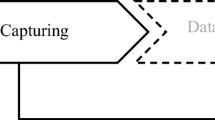Abstract
In the field of optical illusion, reverse perspective is used to draw a scene that is opposite to the actual perspective. When the viewing position is changed, a farther object seems to be always coming toward and following the viewer instead of going away. Therefore, we considered whether the reverse perspective can be applied to a dynamic representation of computer animation using multiple combined monitors. In this research, we arranged three monitors in the shape of a corner cube and tried to determine whether the viewer can recognize the concave corner of the cube as the convex corner through the reverse perspective illusion. Furthermore, we developed a virtual environment that enabled us to simulate the reverse perspective illusion by changing the position, angle, and shape of the screen using a head-mounted display and controllers.
You have full access to this open access chapter, Download conference paper PDF
Similar content being viewed by others
Keywords
1 Introduction
Reverse perspective is a drawing technique in which closer objects are drawn small and farther objects are depicted large. The technique is used to draw a scene such that it is opposite to the actual perspective, in the field of optical illusion. When the viewer changes their viewing position, a farther object seems to be always coming toward and following the viewer instead of going away. In recent years, the reverse perspective has also been used in the field of trick art. In the field of art, Patrick Hughes’ “Reverspective” [1] is well known. In addition, Cook et al. investigated the reverse perspective from the viewpoint of psychology and observed that the depth illusion is induced by the density of grid lines rather than shadows and textures [2].
Many artworks using the reverse perspective method can change their appearance in conjunction with the movement of the user; therefore, it is easy to attract the user’s interest. If the pattern of their appearance can be dynamically changed using projector/monitors, it will be possible to enhance the reverse perspective effect. In this research, we propose a reverse perspective method that can change the image on the surface. To realize our approach, we arranged three monitors in the shape like a corner reflector and tried to determine whether the concave corner of the cube appears to be the convex corner to the viewer as a result of reverse perspective illusion. It is necessary to distort the images for the monitors to strongly induce the reverse perspective effect. Therefore, the projective transformation was utilized for distortion correction, and the deformation parameters that can further enhance the effect were explored.
2 Development of a Corner Cube-Shaped Display
We developed a corner cube-shaped display by combining three LCD monitors. When configuring corners with three monitors, it is preferable to use three regular square monitors without an edge, from the viewpoint of effectively utilizing pixels. However, because it was difficult to find square-shaped bezel-free monitors, we used a square monitor (Eizo EV2730Q, 1920 × 1920) on the front and narrow bezel monitors (Eizo EV2455, 1920 × 1200) on both the left and right sides. Figure 1 shows a combination of displays. The orientation of the monitors was such that the bezel and the wiring are difficult to see.
3 Visual Representation of the Reverse Perspective Effect
It is necessary to draw the created image on each monitor. For example, in the representation of a cube using the reverse perspective method, it is necessary to transform all projection points of the displayed object. However, for the purpose of displaying arbitrary shapes, we decided to utilize projective transformation for distortion correction. In this study, we used a homography transformation that allowed us to project a plane on to another plane by projective transformation. Affine transformation can be used to transform a plane into a parallelogram, but homography transformation has an advantage in that it can to transform the plane into a trapezoid. The distortion ratio was defined as the length of the diagonal divided by the length of one side of the original regular square (Fig. 2). Generation of video including homography transformation was implemented using Unity. The lattice pattern is used because the grid line density increases the optical illusion effect.
Figure 3 shows results if the distortion ratio is changed. The effect of the reverse perspective is greater in the right photograph. The ratio of the photograph in Fig. 2 and the right photograph in Fig. 3 are the same but both photographs were captured from different angles. This means that with changing viewpoint, the cube appears to rotate such that the vertex moves toward the viewer.
4 Evaluation Experiment of Distortion Ratio
The effect of reverse perspective depends on a parameter of the distortion ratio. We verified the range of distortion ratios that causes optical illusion using our corner cube-type monitor. In this experiment, we examine whether the displayed cube is perceived as distorted and whether the corner is recognized as convex.
4.1 Procedure
The experiment is based on the adjustment method. First, the image on the left side of Fig. 3 is displayed as an initial image to the participant in the experiment. Then the participant decreases the distortion ratio until the cube is perceived without distortion. Next, they reduce the ratio until the object is not recognizable as a cube. Finally, they adjust the ratio until the concave corner is not perceived as the convex corner. The criterion of distortion and perspective is based on the subjectivity of the participants. They stood at a position approximately 80 cm away from the center corner of the display and were instructed to see with both eyes. In this study, we conducted the experiment for ten participants aged 19 to 22.
4.2 Results
In Fig. 4, hatched squares represent the range of distortion ratios for which the participants perceived the pattern as an undistorted convex cube. Error bars indicate the range for which the corner is recognized as convex. Individual differences are substantial, but the average of the distortion ratios for which they began to perceive the pattern as a convex cube without distortion is 83.6%. The average of the lowest limitation when they began not to perceive it as a convex cube is 67.9%. The average ratio when they recognized the corner as a convex shape is 54.5%. Figure 5 shows the displayed patterns used in the experiments.
4.3 Considerations
According to the survey results, although there are individual differences in the tolerance of the distortion ratio, most users can perceive the reverse perspective illusion between 83.6% and 67.9%. This result is the same illusion as the environment created by paper.
Moreover, even if the user can not recognized the pattern as a cube, they can see that the vertex continues to jump out. From the survey conducted by changing the gazing point, if the user’s line of sight can be fixed at the vertex, the illusion can be more reliably induced.
5 Simulation in VR Space
From the opinion of the participants of the evaluation experiment, it became apparent that the contents presented on the corner cube-type monitor using the reverse perspective method need improvement in screen size, shape, and texture.
However, because the monitor is fixed with an aluminum frame, it is heavy and not easy to move; therefore, we conducted a simulation in a virtual environment using a head-mounted display. In the preliminary survey, we confirmed that the virtual environment can evoke the same illusion of reverse perspective with monitors.
6 Conclusion
In this research, we created a corner cube-type monitor by stereoscopically combining three monitors and presented contents using reverse perspective using Unity, with many people stereoscopically watching the contents through a reverse perspective. We investigated the distortion ratio that can be made. In addition, we have constructed a virtual environment that can simulate the improvement method of the corner cube type monitor. In future, we propose to verify the combination of monitors and the type of presentation video via a demonstration using a head-mounted display and demonstration by projection mapping and to aim to develop a monitor that can always show information toward to many users at the same time. At present, it is limited to displaying a convex cube using a corner cube-type monitor, but the virtual environment enables us to simulate various shapes such as polyhedrons or spheres.
References
Patrick Hughes Reverspective. http://www.patrickhughes.co.uk/. Accessed 12 Mar 2018
Cook, N.D., Yutsudo, A., Fujimoto, N., Murata, M.: Factors: contributing to depth perception: behavioral studies on the reverse perspective illusion. Spat. Vis. 21(5), 397–405 (2008)
Author information
Authors and Affiliations
Corresponding author
Editor information
Editors and Affiliations
Rights and permissions
Copyright information
© 2018 Springer International Publishing AG, part of Springer Nature
About this paper
Cite this paper
Takeuchi, R., Hashimoto, W., Mizutani, Y., Nishiguchi, S. (2018). Verification of Stereoscopic Effect Induced Parameters of 3D Shape Monitor Using Reverse Perspective. In: Stephanidis, C. (eds) HCI International 2018 – Posters' Extended Abstracts. HCI 2018. Communications in Computer and Information Science, vol 851. Springer, Cham. https://doi.org/10.1007/978-3-319-92279-9_46
Download citation
DOI: https://doi.org/10.1007/978-3-319-92279-9_46
Published:
Publisher Name: Springer, Cham
Print ISBN: 978-3-319-92278-2
Online ISBN: 978-3-319-92279-9
eBook Packages: Computer ScienceComputer Science (R0)









